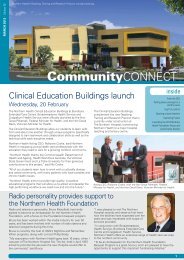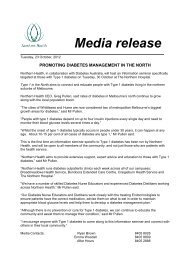Research Week Abstract Book - Northern Health
Research Week Abstract Book - Northern Health
Research Week Abstract Book - Northern Health
You also want an ePaper? Increase the reach of your titles
YUMPU automatically turns print PDFs into web optimized ePapers that Google loves.
Orthopaedics<br />
ORTHOPAEDICS<br />
DisTAL RADIAL FRACTURES IN ChilDren: RISK FACTors FOR<br />
REDISPlaCEMENT FOLLOWING CloseD REDUCTion<br />
Asadollahi, S and Hau RC<br />
Background<br />
Distal radial fractures represent one of the most common fractures in children; the majority are treated by closed reduction<br />
and cast application. Redisplacement after manipulation can occur resulting in potential poor outcome.<br />
Aim<br />
The aim of the study was to evaluate a range of possible risk factors contributing to loss of reduction in children undergoing<br />
closed reduction of distal radial fracture. We also reviewed the cohort of cases treated with Kirschner wires for associated<br />
complications.<br />
Methodology<br />
The prospective study included 135 displaced distal radial fractures. There were 48 girls (36%) and 87 boys (64%), with<br />
a mean age of 9.9 years (3-17 years). The risk factors for redisplacement evaluated included: age, gender, location of the<br />
fracture, preoperative fracture displacement, presence of ulna fracture, grade of surgeon, quality of reduction, quality of<br />
plaster, and residual post reduction displacement.<br />
Results<br />
Redisplacement occurred in 39 of 135 cases (28.8%). Initial complete displacement was the most important risk factor for<br />
loss of reduction (Odds ratio 6.94, p=0.001). Completely displaced fractures were 7 times more likely to redisplace than<br />
fractures with some bony contact or no translation. Achievement of anatomic reduction decreases the risk of redisplacement<br />
(Odds ratio 0.29, p=0.046). The complication rate from K-wire fixation was 46% (7 of 15 cases) with pin site infection being<br />
the most common.<br />
Conclusion<br />
Completely displaced distal radial fractures that cannot be anatomically reduced have a high risk of redisplacement after<br />
closed reduction. K-wire use in management of displaced distal radial fracture is associated with a high rate of complication.<br />
53

















